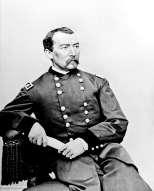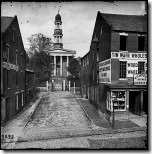Why Cinco de Mayo is also a U.S. holiday
May 5, 2015 § Leave a comment
Cinco de Mayo is more than Mexican cultural and historical event.
Cinco de Mayo celebrates the post Mexican War (1846-1848) friendship between our countries and American support for the Mexican struggle to regain independence from France.
In 1861 during the U.S. Civil War, France sent troops to Mexico and made Mexico into a French colony.
The U.S. was still committed to its foreign policy of opposing by force attempts to recolonize any American nation that had won their independence (the Monroe Doctrine). The Civil War prevented the U.S. from enforcing that policy. As Lincoln said regarding another dispute, only one war at a time.
However, Mexico resisted.
On May 5, 1862, at Pueblo outside of Mexico City, Mexican irregulars, guerrillas, and militia defeated the invading French forces.
While the French lost that battle, they still were able to capture Mexico City and impose colonial rule.
Despite losing their capitol and government, Mexico continued to resist.
Abraham Lincoln and the Union supported the Mexicans while the Confederacy hoped to trade support for the French colonization of Mexico for recognition of Confederate independence.
At Lincoln’s order in late 1863 Union forces landed from the Gulf of Mexico and seized Brownsville, Texas as a show of force and a warning to France.
After the surrender of the Confederacy, 50,000 Federal troops under General Philip Sheridan were deployed to Texas.
That force was responsible for the occupation of Texas, Reconstruction, and to patrol the border with Mexico to as a warning to France to withdraw their troops from France.

General Philip Sheridan commander of the U.S. forces deployed to the Texas including the border with Mexico.
1860s photo by Matthew Brady
France withdrew and the Mexicans overthrew the colonial government, completing their struggle which began with their victory on the first Cinco de Mayo.
The success of the Mexican resistance restored Mexican independence and saved the U.S. from engaging in another war immediately after the Civil War.
Napoleon III’s defeat in Mexico also was a victory for the French resistance to his dictatorship.
Cinco de Mayo was one in a series of events over eight years that resulted in his fall and the restoration of democracy in France with the establishment of the Third Republic in 1870.
That’s something all three nations can celebrate together.
I wrote this in reaction to white supremacists advocating making Cinco de Mayo “Turn in an Illegal Day”.
In depth historical background and context are occasional features of my family history blogs.
Originally posted on May 5, 2010 on Leonard’s Critical Thinking with a Cynical Edge.
Revised: May 3, 2019
Shortlink: http://wp.me/p5YuOj-1E
Anson Croman and the 20th Michigan in the Appomattox Campaign 150 Years Ago
April 9, 2015 § 1 Comment

Orange ellipse, lower right: Location of the 20th Michigan at Sutherland Station, Virginia in a support position for the troops that pursued and trapped Lee’s army at Appomattox. Click on map for larger image.
Public domain image from the United States Military Academy (West Point) History Department’s American Civil War Atlas
150 years ago over the night of April 2-3, 1865 Robert E. Lee and the Army of Northern Virginia retreated from Richmond to link up with General Johnson’s Army of Tennessee just to south in North Carolina.
Pursuing Union troops blocked every road south so Lee’s army was forced to retreat to the west.
The IXth Corps which included the 20th Michigan supported the pursuit by protecting the Union’s southern flank. The IXth Corps was also quickly repairing the South Side Railroad to supply the pursuing troops by rail.
Anson Croman and the 20th Michigan Infantry Regiment were in a support position at the Sutherland Station southwest of Richmond and west of Petersburg.
On April 9, the Union trapped General Lee at Appomattox finally forcing him to surrender to General Grant.
That is considered the symbolic end of the Civil War.
The last of the Confederate forces west of the Mississippi River surrendered in June marking the actual end of the Civil War.
Why Lee May Not Have Surrendered Earlier
After President Lincoln’s reelection in November, 1864, any hope of winning Confederate independence through war or negotiations ended.
Several times earlier in the war, Confederate generals surrendered without their troops being completely trapped and on the verge of total destruction as were General Lee’s forces at Appomattox.
As did those other Confederate generals, General Lee had the authority and opportunity to surrender.
University of Virginia historian Elizabeth R. Varnon suggests that General Lee knew independence was no longer possible and slavery was over.
Professor Varnon’s analysis is that General Lee held out as long as he did in order to place the Southern aristocracy in the strongest position possible to preserve as many of their privileges as possible including in race relations.
Links, sources, and more information:
 Appomattox: Victory, Defeat, and Freedom at the End of the Civil War by Elizabeth R. Varon
Appomattox: Victory, Defeat, and Freedom at the End of the Civil War by Elizabeth R. Varon
1865: Anson Croman and the Civil War
If Anson Croman wrote letters home, none have survived. Therefore the best way to preserve the story of his service is by sharing the history of his regiment
Records document that Anson Croman was with his regiment from his 1862 enlistment until the Confederate surrender at Appomattox, Virginia in 1865.
The Musbachs and Robinsons are direct line descendants of Anson Croman and he is my 2nd great-grandfather-in-law.
Shortlink: http://wp.me/p5YuOj-1w
150 Years Ago the 20th Michigan Enters Petersburg
April 3, 2015 § 1 Comment
By the end of March, 1865, Union and Confederate forces faced each others along 37 miles of trenches from north of Richmond to southwest of Petersburg.
The Confederates had suffered major losses in an unsuccessful attempt to break out and escape followed by an unsuccessful effort to prevent the Union forces from outflanking those trenches about eight miles southwest of Petersburg.
The few Confederates remaining in the trenches hungry and at their breaking point.
On April 2, 1865, the Union attacked seeking a breakthrough at a weak point. the IXth Corps attacked from their positions just south of the Appomattox River and east of Petersburg. Anson Croman and the 20th Michigan Infantry Regiment were in the IXth Corps. They were position north of the attack ready to provide support.
The IXth Corps captured the Confederate Fort Mahone but was blocked by the Confederates from advancing further.
However, other Union units broke through at several places to the south and west forcing the Confederates to evacuate and retreat from both Petersburg and Richmond. The next day April 3, 1865, the Union army entered Petersburg.
The 20th Michigan was the third unit to raise its flag over the Petersburg courthouse.
Meanwhile, Abraham Lincoln, who was nearby at Grant’s headquarters at City Point, Virginia, toured the battlefield.
Links, sources, and more information:
1865: Anson Croman and the Civil War
If Anson Croman wrote letters home, none have survived. Therefore the best way to preserve the story of his service is by sharing the history of his regiment
Records document that Anson Croman was with his regiment from his 1862 enlistment until the Confederate surrender at Appomattox, Virginia in 1865.
The Musbachs and Robinsons are direct line descendants of Anson Croman and he is my 2nd great-grandfather-in-law.
Shortlink: http://wp.me/p5YuOj-1c
150th anniversary of Anson Croman shaking hands with Abraham Lincoln on October 8, 1862
October 6, 2012 § Leave a comment
Cizewski, Lovetere, Musbach, & Robinson Families
 Charles Wellington Reed’s pencil sketch of
Charles Wellington Reed’s pencil sketch of
Abraham Lincoln at City Point, Virginia, 1865.
(Library of Congress)
Following their late September, 1862 care for the battlefield dead at Antietam, Anson Croman and the 20th Michigan were stationed near Sharpsburg, Maryland.
On October 8, 1862 Abraham Lincoln reviewed the 20th Michigan Infantry Regiment.
That is most likely time when Anson Croman shook Abraham Lincoln’s hand.
Years later, Anson would proudly invite his great-grandchildren to “shake the hand that shook Lincoln’s”.
The above drawing may be the best contemporary illustration of Abraham Lincoln shaking hands with the troops.
It is not of Anson or the 20th Michigan.
Assistant topographical engineer Lt. Charles Wellington Reed drew this of other soldiers and another unit at City Point, Virginia in 1865.
At the time and place of this sketch, the 20th Michigan was stationed a few miles to the west in the siege…
View original post 13 more words



